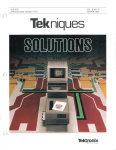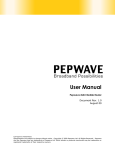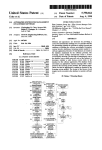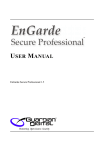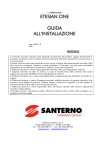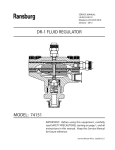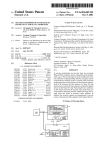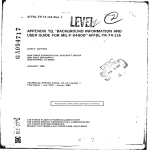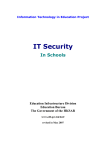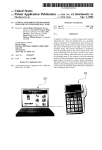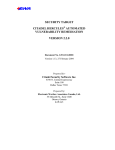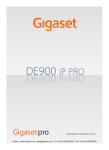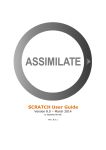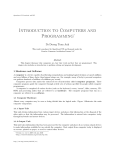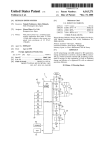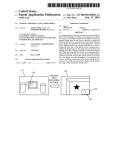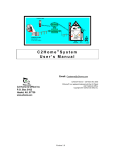Download System and Methodology for Intrusion Detection and Prevention
Transcript
l|||||||||||||ll||l||||||||l|||||||||||||||||||||l||||||||||l||||||||||||||||||||||||||||| US 20050273857A1 (19) United States (12) Patent Application Publication (10) Pub. No.: US 2005/0273857 A1 Freund (54) (43) Pub. Date: SYSTEM AND METHODOLOGY FOR INTRUSION DETECTION AND Dec. 8, 2005 Publication CIHSSI?CHtIOIl PREVENTION (51) Int. Cl.7 ............................ .. H04L 9/00; H04L 9/32; Inventor: (52) US Cl. .............................................................. .. 726/23 G06F 12/14; G06F 11/30 (75) Gregor Paul Freund, San Francisco, CA (US) (57) ABSTRACT Correspondence Address: JOHN A. SMART 708 BLOSSOM HILL RD., #201 System and methodology for intrusion detection and pre vention is described. In one embodiment, for example, a LOS GATOS, CA 95032 (US) method is described for detecting and preventing network intrusion, the method comprises steps of: de?ning intrusion (73) Assignee: CHECK POINT SOFTWARE TECH NOLOGIES, INC., Redwood City, CA (Us) 21 A 1' N ‘I descriptions specifying exploits that may be attempted by malicious network traf?c, the intrusion descriptions indicat ing speci?c applications that may be targeted by individual exploits; for a particular application participating in network 10 907 335 communication, deriving a subset of the intrusion descrip / ’ Man 29, 2005 Related US Application Data tions speci?cally applicable to that particular application; using the subset of the intrusion descriptions speci?cally applicable to that application, monitoring network traf?c destined for the particular application for detecting an (60) Provisional application No, 60/521,624, ?led on Jun' 7, 2004. detected, blocking network traf?c destined for the particular application determined to comprise an exploit. ( ) pp (22) Filed: 0 attempted network intrusion; and if a network intrusion is 440 k V \C// \NTRUSION DESCRIPTIONS 430 X I 407 x ENGINE APPLICATION(S) 405 \ COMMUNICATION PROTOCOL (9.9., WINSOCK) usER MODE 413 w APPLICATION LEvEL FILTER ‘ ' APPLICATION STATE INFO N 423 403 \ ssL VPN—> TCP/IP 411 w FIREWALL <_> csajggclgg‘l /\_,421 401 \ NETWORK ADAPTER INTERNET Patent Application Publication Dec. 8, 2005 Sheet 1 0f 7 mop No? I 2 U1 0 O E E J 0: 20 J US 2005/0273857 A1 Patent Application Publication Dec. 8, 2005 Sheet 2 0f 7 US 2005/0273857 A1 M f- 201a /-—201b f 201:: APPLICATION APPLICATION BROWSER PROGRAM 1 PROGRAM 2 PROGRAM I M I II I [ 1 /— 201d APPLICATION 201 PROGRAM N I OPERATING SYSTEM (e.g., WINDOWS 9X/NT/2000/XP, SOLARIS, UNIX, LINUX, MAC OS, OR LIKE) GRAPHICAL USER INTERFACE f‘ 220 DEVICE DRIVERS (e.g., WINSOCK) A A 230 y /_ BIOS (MICROCODE) A DISPLAY MONITOR NETWORK INTERFACE COMM PORT KEYBOARD MODEM MOUSE DISKS PRINTER FIG. 2 215 \ 210 Patent Application Publication Dec. 8, 2005 Sheet 3 0f 7 US 2005/0273857 A1 C) C) ‘(a 307 \ APPLICATION(S) 305 \ COMMUNICATION PROTOCOL (e.g., WINSOCK) USER MODE TCP/IP NETWORK ADAPTER FIG. 3 Patent Application Publication Dec. 8, 2005 Sheet 4 0f 7 407 US 2005/0273857 A1 \ APPLICATION(S) 405 \ COMMUNICATION PROTOCOL (e.g., WINSOCK) USER MODE APPLICATION LEVEL FILTER TCP/IP 411 \_/‘ 401 FIREWALL \ NETWORK ADAPTER FIG. 4A Patent Application Publication Dec. 8, 2005 Sheet 5 0f 7 US 2005/0273857 A1 440 INTRUSION DESCRIPTIONS 430 x 407 X I ENGINE APPLICATION(S) 405 \ COMMUNICATION PROTOCOL (e.g., WINSOCK) USER MODE APPLICATION 413 ‘f APPLICATION LEvEL FILTER ' ' STATE INFO N 423 403 x ssL VPN TCP/IP 411 \_/\ FIREWALL H 401 \ NETWORK ADAPTER INTERNET FIG. 4B CONNECTION STATE INFO /\_, 421 Patent Application Publication Dec. 8, 2005 Sheet 6 0f 7 ( BEGIN ) US 2005/0273857 A1 m ‘F K 501 APPLICATION STATE OBJECT CREATED IN RESPONSE TO OPENING INCOMING OR OUTGOING CONNECTION TO A PARTICULAR APPLICATION (OR PROGRAM OR COMPONENT) 502 v K PARTICULAR APPLICATION TO WHICH CONNECTION IS OPEN IS VERIFIED v K- 503 PROTOCOL IS VERIFIED SO THAT THE OPERATION(S) THE APPLICATION OPENING THE CONNECTION IS TRYING TO PERFORM CAN BE BETTER UNDERSTOOD v K~ 504 DETERMINE SET (LIST) OF INTRUSION DESCRIPTIONS APPLICABLE TO THIS PARTICULAR APPLICATION BASED UPON APPLICATION STATE OBJECT AND PROTOCOL v F 505 LIST OF INTRUSION DESCRIPTIONS ASSOCIATED WITH (ATTACHED TO) APPLICATION STATE OBJECT 506 v K REPEAT STEPS 501-505 FOR CREATION OF APPLICATION STATE OBJECTS FOR CONNECTIONS OPENED TO ADDITIONAL APPLICATIONS 507 v K TRANSFORM APPLICATION STATE OBJECT(S) INTO HASH AND STORE IN HASH TABLE V I DONE FIG. 5 I Patent Application Publication Dec. 8, 2005 Sheet 7 0f 7 ( BEGIN US 2005/0273857 A1 ) w ‘V r 601 INTERCEPT INCOMING OR OUTGOING DATA PACKET OR STREAM v r 602 ATTRIBUTES IN DATA PACKET(S) USED TO FIND THE APPROPRIATE APPLICATION STATE (E.G., VIA HASHING ATTRIBUTES FOR LOOKUP IN HASH TABLE OF APPLICATION STATE OBJECTS) v f 603 ENGINE EXAMINES DATA PACKET(S) FOR DETECTING INTRUSIONS BASED ON LIST OF INTRUSION DESCRIPTIONS ASSOCIATED WITH APPLICATION STATE OBJECT v r IF INTRUSION DETECTED AT STEP 603, ACTION TAKEN IN RESPONSE TO INTRUSION WHICH MAY INCLUDE ALERTING USER, LOGGING INFORMATION TO A FILE, BLOCKING TRAFFIC, AND/OR FIXING TRAFFIC V I DONE FIG. 6 I 604 Dec. 8, 2005 US 2005/0273857 A1 SYSTEM AND METHODOLOGY FOR INTRUSION DETECTION AND PREVENTION CROSS REFERENCE TO RELATED APPLICATIONS [0008] As more and more computers are noW connected to the Internet, either directly (e.g., over a dial-up or broadband connection With an Internet Service Provider or “ISP”) or through a gateWay betWeen a LAN and the Internet, a Whole neW set of challenges face LAN administrators and indi [0001] The present application is related to and claims the bene?t of priority of the following commonly-oWned, pres vidual users alike: these previously closed computing envi ently-pending provisional application(s): application Ser. systems. A particular set of challenges involves attacks by perpetrators (hackers) capable of damaging the local com puter systems, misusing those systems, and/or stealing pro prietary data and programs. No. 60/521,624 (Docket No. VIV/0017.00), ?led Jun. 7, 2004, entitled “System and Methodology for Intrusion Detection and Prevention”, of Which the present application is a non-provisional application thereof. The present appli cation is related to the following commonly-oWned, pres ronments are noW open to a WorldWide netWork of computer [0009] The softWare industry has, in response, introduced ently-pending application(s): application Ser. No. 60/521, a number of products and technologies to address and 623 (Docket No. VIV/0016.00), ?led Jun. 7, 2004, entitled minimize these threats, including “?reWalls”, proxy servers, and similar technologies—all designed to keep malicious users (e.g., hackers) from penetrating a computer system or corporate netWork. FireWalls are applications that intercept “Security System With Methodology Providing Veri?ed Secured Individual End Points”; application Ser. No. 10/907, 331 (Docket No. VIV/0016.01), ?led Mar. 29, 2005, entitled “Security System With Methodology Providing Veri?ed the data traffic at the gateWay to a Wide Area NetWork Secured Individual End Points”. The disclosures of each of (“WAN”) and check the data packets (i.e., Internet Protocol packets or “IP packets”) being exchanged for suspicious or the foregoing applications are hereby incorporated by ref erence in their entirety, including any appendices or attach ments thereof, for all purposes. COPYRIGHT STATEMENT [0002] Aportion of the disclosure of this patent document contains material Which is subject to copyright protection. unWanted activities. [0010] Another security measure that has been utiliZed by many users is to install an end point security (or personal ?reWall) product on a computer system to control traf?c into and out of the system. An end point security product can regulate all traf?c into and out of a particular computer. One The copyright oWner has no objection to the facsimile such product is assignee’s ZoneAlarm® product that is reproduction by anyone of the patent document or the patent described in detail in US. Pat. No. 5,987,611, the disclosure disclosure as it appears in the Patent and Trademark Of?ce patent ?le or records, but otherWise reserves all copyright of Which is hereby incorporated by reference. For example, an end point security product may permit speci?c “trusted” rights Whatsoever. BACKGROUND OF INVENTION [0003] 1. Field of the Invention [0004] The present invention relates generally to computer security and, more particularly, to a system and methodol ogy for detecting and preventing intrusions on a per-appli cation basis. [0005] 2. Description of the Background Art applications to access the Internet While denying access to other applications on a user’s computer. To a large extent, restricting access to “trusted” applications is an effective security method. HoWever, despite the effectiveness of end point security products, issues remain in protecting com puter systems against attack by malicious users and appli cations. [0011] One problem that remains is that trusted applica tions often have knoWn vulnerabilities that make then sus ceptible to attack or exploitation by hackers and other The ?rst computers Were largely stand-alone units malicious users. Avulnerability is a feature or a combination With no direct connection to other computers or computer of features of a system that alloWs a malicious adversary to place the system in a state that is both contrary to the desires [0006] netWorks. Data exchanges betWeen computers Were mainly accomplished by exchanging magnetic or optical media such as ?oppy disks. Over time, more and more computers Were connected to each other using Local Area NetWorks or “LANs”. In both cases, maintaining security and controlling of the user(s) of the system and increases the risk (prob ability or consequence) of undesirable behavior. These vul nerabilities may include, for example, coding errors in applications, means for bypassing certain security safe What information a computer user could access Was rela guards, and the like. An example of a vulnerability is a tively simple because the overall computing environment program With a buffer that can be over?oWed With data Was limited and clearly de?ned. supplied by the invoker. The vulnerability may also prevent the successful implementation of a particular security policy [0007] With the ever-increasing popularity of the Internet, hoWever, more and more computers are connected to larger netWorks. Providing access to vast stores of information, the Internet is typically accessed by users through Web “broWs ers” (e.g., Microsoft® Internet Explorer or Netscape Navi gator) or other Internet applications. BroWsers and other Internet applications include the ability to access a URL for the system. [0012] In an ideal case, a user or system administrator that is informed that a program (e.g., application) he or she is using has knoWn vulnerabilities Will upgrade the program (e.g., apply a patch) in order to address the speci?c vulner abilities that have been discovered. HoWever, in many cases, applying a patch or otherWise upgrading an application to (Universal Resource Locator) or “Web” site. In the last several years, the Internet has become pervasive and is used not only by corporations, but also by a large number of small address knoWn problems is not practicable. One problem is that certain Widely used programs (e.g., for the Microsoft business and individual users for a Wide range of purposes. WindoWs environment) may require frequent application of Dec. 8, 2005 US 2005/0273857 A1 patches to address security vulnerabilities. The sheer volume of patches that may be required can deter many users from applying them. [0013] Another obstacle is that applying a patch may cause other problems. Users testing patches before applying them sometimes encounter con?icts and incompatibilities With other programs and/or errors in the patches. These con?icts and errors generally result from the fact that patches are released With little or no testing in an attempt to rapidly respond to reported errors and vulnerabilities. Because patches are usually not subjected to rigorous testing (e.g., beta test programs), they may sometimes introduce more problems than they solve. Many users, particularly more experienced users, are reluctant to install patches for this reason. [0014] Users are also deterred from applying patches by the fact that in many cases the patches that need to be applied are quite large (e. g., in the case of operating system patches). In particular, the siZe of doWnload ?les may deter users that only have limited bandWidth available for ?le doWnloads (e.g., users With a dial-up connection to the Internet). For reasons such as these, many users do not apply all patches and continue to use applications With knoWn vulnerabilities for extended periods of time. [0015] Another alternative for protecting against knoWn system vulnerabilities is to use intrusion detection and/or intrusion prevention solutions. Typically, both intrusion detection and intrusion prevention solutions Work by moni toring the traffic on the netWork, noting Which devices they are communicating With, and categoriZing the types of traf?c interacting With the devices. Traf?c patterns are then com pared against knoWn attack or exploit signatures. Generally, an attack is an action conducted by an adversary or intruder as “IDS”) is that these solutions are notorious for reporting a large number of “false positives”. A false positive is an event Which is incorrectly identi?ed by the IDS as being an intrusion When none has occurred. In other Words, current solutions frequently report and/or block innocent traf?c. Blocking innocent traf?c, in particular, can be problematic as it introduces the possibility of random netWork failure based on the (incorrect) matching of traf?c With signatures of knoWn exploits. On the other hand, if the IDS uses more narroW pattern matching criteria, then it is less effective as the IDS only recogniZes common instances of knoWn exploits and may not detect attacks having minor variations from the common case. For example, a personal computer may be subject to an RPC (remote procedure call) exploit because of a vulnerability of the operating system. If the pattern-matching criteria is de?ned narroWly (e.g., so as to avoid issuance of “false positives”), then the IDS may detect an MS-Blast attack, but not the entire class of RFC exploits to Which the computer may be vulnerable. In practice, providing greater security using current intrusion detection/ prevention solutions comes at the expense of requiring the user (or administrator) to sort through a larger number of reported attacks that turn out to be false positives. [0018] Another limitation of current solutions is in han dling encrypted traf?c. Message encryption is a problem, especially for netWork-based intrusion systems. Encryption makes the practice of looking for particular patterns in packet bodies dif?cult if not impossible using current solu tions. Useful analysis can be performed only after the message has been decrypted on the target host, and this often occurs Within a speci?c application or at a level Which cannot be detected by current intrusion detection/prevention solutions. With a speci?c objective in mind against a victim. From the [0019] perspective of the victim (e.g., a user or administrator responsible for maintaining a system), an attack is a set of mine speci?c exploits that may apply in particular circum stances enabling a more focused examination of Whether one or more events that may have one or more security particular traf?c matches the pattern of the exploits that may consequences. An exploit is the process of using a system vulnerability to violate a system security policy. A tool or de?ned method that could be used to violate a security policy is often referred to as an exploit script. An exploit seeks, in some Way, to take advantage of a vulnerability in a system in the pursuit or achievement of some objective. All vulnerability exploitations are attacks, but not all attacks exploit vulnerabilities. For purposes of the folloWing dis cussion both attacks and exploits Will generally be referred to as “exploits” or “intrusions”. [0016] Intrusion detection and prevention solutions seek to detect and prevent intrusions (i.e., attacks and exploits). These solutions typically use knoWn signatures to recogniZe traf?c patterns (pattern-matching), similar to the Way anti virus products use knoWn signatures to recogniZe viruses. What is needed is a solution that is able to deter apply in particular circumstances. Ideally, the solution should enable intrusions to be more accurately detected and prevented, While also minimiZing the number of false posi tives that are generated by the solution. The present inven tion provides a solution for these and other needs. SUMMARY OF INVENTION [0020] System and methodology for intrusion detection and prevention is described. In one embodiment, for example, a method of the present invention is described for detecting and preventing netWork intrusion, the method comprises steps of: de?ning intrusion descriptions specify ing exploits that may be attempted by malicious netWork traffic, the intrusion descriptions indicating speci?c appli cations that may be targeted by individual exploits; for a The signatures are often based on malicious TCP/IP packets, particular application participating in netWork communica since hackers commonly try to manipulate those packets to tion, deriving a subset of the intrusion descriptions speci? perform a malicious action. Intrusion detection solutions report (i.e., Warn the user of) patterns that indicate a possible cally applicable to that particular application; using the uring selected ?reWalls, or taking other actions in response subset of the intrusion descriptions speci?cally applicable to that application, monitoring netWork traf?c destined for the particular application for detecting an attempted netWork intrusion; and if a netWork intrusion is detected, blocking netWork traffic destined for the particular application deter to the detection of any intrusion. mined to comprise an exploit. [0017] A problem With current intrusion detection and intrusion prevention solutions (sometimes referred to herein [0021] In another embodiment, for example, a netWork intrusion detection and prevention system of the present attack (e.g., based upon certain thresholds and severity levels). Intrusion prevention solutions go further by block ing suspicious traf?c, terminating the connection, recon?g Dec. 8, 2005 US 2005/0273857 A1 invention is described that comprises: a plurality of intrusion descriptions specifying exploits that may be attempted by malicious netWork traf?c, the intrusion descriptions indicat ing speci?c applications that may be targeted by individual exploits; a module for deriving a subset of the intrusion descriptions speci?cally applicable to that particular appli cation for a particular application participating in netWork communication; and an application ?lter for monitoring netWork traf?c destined for the particular application for detecting an attempted netWork intrusion using the subset of the intrusion descriptions speci?cally applicable to that application, and for blocking netWork traf?c destined for the particular application determined to comprise an exploit. [0022] In yet another embodiment, for example, an improved netWork intrusion detection and prevention sys tem, the improvement comprises: splitting netWork traf?c into different streams of netWork packets, based on Which respective application each individual netWork packet is destined for; for a given stream and its respective applica tion, determining particular intrusion detection signatures applicable to that respective application; and applying intru sion detection and prevention to the given stream using the particular intrusion detection signatures applicable to the given stream’s respective application. [0023] In another embodiment, for example, a system of the present invention for blocking malicious netWork traf?c is described that comprises: means for storing a repository specifying on a per-application basis various exploits that may be attempted by netWork traf?c; means, responsive to the repository, for application-speci?c monitoring of net Work traf?c, such that only netWork traf?c destined for a particular application is examined for exploits relevant to that particular application; and means, responsive to the means for application-speci?c monitoring, for blocking net Work traf?c identi?ed as an exploit. BRIEF DESCRIPTION OF DRAWINGS [0024] FIG. 1 is a very general block diagram of a computer system (e.g., an IBM-compatible system) in Which softWare-implemented processes of the present invention may be embodied. [0025] FIG. 2 is a block diagram of a softWare system for controlling the operation of the computer system. DETAILED DESCRIPTION [0031] Glossary [0032] The folloWing de?nitions are offered for purposes of illustration, not limitation, in order to assist With under standing the discussion that folloWs. [0033] End point security: End point security is a Way of managing and enforcing security on each computer instead of relying upon a remote ?reWall or a remote gateWay to provide security for the local machine or environment. End point security involves a security agent that resides locally on each machine. This agent monitors and controls the interaction of the local machine With other machines and devices that are connected on a LAN or a larger Wide area netWork (WAN), such as the Internet, in order to provide security to the machine. [0034] FireWall: A ?reWall is a set of related programs, typically located at a netWork gateWay server, that protects the resources of a private netWork from other netWorks by controlling access into and out of the private netWork. (The term also implies the security policy that is used With the programs.) A ?reWall, Working closely With a router pro gram, examines each netWork packet to determine Whether to forWard it toWard its destination. A ?reWall may also include or Work With a proxy server that makes netWork requests on behalf of users. A ?reWall is often installed in a specially designated computer separate from the rest of the netWork so that no incoming request directly accesses pri vate netWork resources. [0035] Hash: A hash (or hash value) is a smaller data type (e.g., number) that represents another, larger, data type (usually a string). A hash is typically a number that is generated from a string of text by a hashing function. The hash is substantially smaller than the text itself, and is generated in such a Way that it is unlikely that some other text Will produce the same hash value. Hashes play a role in security systems (e. g., to ensure that transmitted messages or ?les have not been tampered With). Hashing is also a method for facilitating access to data records. Consider, for example, a list of names: John Smith, Sarah Jones, and Roger Adams. To create an index, called a hash table, for these records, one Would apply a hashing function to each name to produce a unique numeric value such as the folloWing: 1345873 John Smith, 3097905 Sarah Jones, 4060964 Roger Adams. To search for the record containing the name Sarah Jones, one just needs to reapply the hashing function, Which directly yields the index key to the record. This is much more [0026] FIG. 3 is a block diagram illustrating a communi cation stack. ef?cient than searching through all the records until the matching record is found. [0027] traf?c may be conveniently intercepted. [0036] HTTP: HTTP is the acronym for HyperText Trans fer Protocol, Which is the underlying communication pro [0028] FIG. 4B is a diagram illustrating components of the intrusion detection/prevention system of the present tocol used by the World Wide Web on the Internet. HTTP de?nes hoW messages are formatted and transmitted, and What actions Web servers and broWsers should take in FIG. 4A is an adaptation of FIG. 3 shoWing Where invention. [0029] FIG. 5 is a high-level ?oWchart illustrating the set up and initialiZation of the system of the present invention response to various commands. For example, When a user enters a URL in his or her broWser, this actually sends an HTTP command to the Web server directing it to fetch and for detecting and preventing intrusions. transmit the requested Web page. Further description of [0030] FIG. 6 is a high-level ?oWchart illustrating the operations of the system of the present invention in evalu ating traf?c in order to detect and prevent intrusions. tocol—HTTP/1.1,” the disclosure of Which is hereby incor porated by reference. RFC 2616 is available from the World Wide Web Consortium (W3C), and is available via the HTTP is available in “RFC 2616: Hypertext Transfer Pro Dec. 8, 2005 US 2005/0273857 A1 Internet (e.g., currently at WWW.W3.org/Protocols/). Addi employed by an individual or by a corporation, government tional description of HTTP is available in the technical and trade literature, see e.g., Stallings, W., “The Backbone of the Web,” BYTE, October 1996, the disclosure of Which is entity, or any other organiZation operating a netWork or other computing resources. hereby incorporated by reference. Layer, a protocol developed by Netscape for transmitting [0037] private documents over the Internet. SSL Works by using a public key to encrypt data that is transferred over the SSL MDS: MDS is a message-digest algorithm Which takes as input a message of arbitrary length and produces as output a 128-bit “?ngerprint” or “message digest” of the input. The MDS algorithm is used primarily in digital signature applications, Where a large ?le must be “com pressed” in a secure manner before being encrypted With a [0041] SSL: SSL is an abbreviation for Secure Sockets connection. Both Netscape Navigator and Microsoft Internet Explorer support SSL, and many Web sites use the protocol to obtain con?dential user information, such as credit card numbers. SSL creates a secure connection betWeen a client and a server, over Which data can be sent securely. For private (secret) key under a public-key cryptosystem. Fur further information, see e.g., “The SSL Protocol, version ther description of MDS is available in “RFC 1321: The MDS Message-Digest Algorithm”, (April 1992), the disclo 3.0”, (Nov. 18, 1996), from the IETF, the disclosure of Which is hereby incorporated by reference. See also, e.g., sure of Which is hereby incorporated by reference. Acopy of RFC 1321 is available via the Internet (e.g., currently at the IETF. A copy of RFC 2246 is available via the Internet WWW.ietf.org/rfc/rfc1321.tXt). (e.g., currently at WWW.itef.org/rfc/rfc2246.tXt). [0038] [0042] TCP: TCP stands for Transmission Control Proto col. TCP is one of the main protocols in TCP/IP netWorks. Network: A netWork is a group of tWo or more systems linked together. There are many types of computer netWorks, including local area netWorks (LANs), virtual “RFC 2246: The TLS Protocol, version 1.0”, available from Whereas the IP protocol deals only With packets, TCP private netWorks (VPNs), metropolitan area netWorks enables tWo hosts to establish a connection and eXchange (MANs), campus area netWorks (CANs), and Wide area streams of data. TCP guarantees delivery of data and also guarantees that packets Will be delivered in the same order netWorks (WANs) including the Internet. As used herein, the term “netWork” refers broadly to any group of tWo or more in Which they Were sent. For an introduction to TCP, see e. g., computer systems or devices that are linked together from “RFC 793: Transmission Control Program DARPA Internet time to time (or permanently). Program Protocol Speci?cation”, the disclosure of Which is hereby incorporated by reference. A copy of RFC 793 is available via the Internet (e.g., currently at WWW.ietf.org/ [0039] RPC: RPC stands for remote procedure call, a type of protocol that alloWs a program on one computer to execute a program on another computer (e.g., a server computer). Using RPC, a system developer need not develop speci?c procedures for the server. The client program sends a message to the server With appropriate arguments and the server returns a message containing the results of the pro rfc/rfc793.tXt). [0043] TCP/IP: TCP/IP stands for Transmission Control Protocol/Internet Protocol, the suite of communications pro tocols used to connect hosts on the Internet. TCP/IP uses several protocols, the tWo main ones being TCP and IP. TCP/IP is built into the UNIX operating system and is used gram eXecuted. For further description of RPC, see e.g., RFC 1831 titled “RPC: Remote Procedure Call Protocol by the Internet, making it the de facto standard for trans Speci?cation Version 2”, available from the Internet Engi neering Task Force (IETF), the disclosure of Which is hereby incorporated by reference. A copy of RFC 1831 is available via the Internet (e.g., currently at WWW.ietf.org/rfc/ Which is hereby incorporated by reference. A copy of RFC 1180 is available via the Internet (e.g., currently at WWW.i rfc1831.tXt). [0040] Security policy: In general terms, a security policy is an organiZation’s statement de?ning the rules and prac tices that regulate hoW it Will provide security, handle intrusions, and recover from damage caused by security breaches. An eXplicit and Well-de?ned security policy includes a set of rules that are used to determine Whether a given subject Will be permitted to gain access to a speci?c object. A security policy may be enforced by hardWare and softWare systems that effectively implement access rules for access to systems and information. Further information on security policies is available in “RFC 2196: Site Security Handbook, (September 1997)”, the disclosure of Which is hereby incorporated by reference. A copy of RFC 2196 is available from the IETF via the Internet (e.g., currently at WWW.ietf.org/rfc/rfc2196.tXt). For additional information, see also, e.g., “RFC 2704: The KeyNote Trust Management System Version 2”, the disclosure of Which is hereby incor porated by reference. Acopy of RFC 2704 is available from the IETF via the Internet (e.g., currently at WWW.ietf.org/ rfc/rfc2704.tXt). In this document, “security policy” or “policy” refers to a set of security policies and rules mitting data over netWorks. For an introduction to TCP/IP, see e.g., “RFC 1180: A TCP/IP Tutorial”, the disclosure of etf.org/rfc/rfc1180.tXt). [0044] UDP: UDP stands for User Datagram Protocol, a connectionless protocol that, like TCP, runs on top of IP netWorks. Unlike TCP/IP, UDP/IP provides very feW error recovery services, offering instead a direct Way to send and receive datagrams over an IP netWork. UDP is used prima rily for broadcasting messages over a netWork. For addi tional information on UDP, see RFC 768, “User Datagram Protocol”, the disclosure of Which is hereby incorporated by reference. A copy of RFC 768 is available via the Internet (e.g., currently at WWW.ietf.org/rfc/rfc768.tXt). [0045] VPN: VPN stands for Virtual Private NetWork, a netWork that is constructed by using public Wires to connect nodes. For eXample, there are a number of systems that enable creation of netWorks using the Internet as the medium for transporting data. These systems use encryption and other security mechanisms to ensure that only authoriZed users can access the netWork and that the data cannot be intercepted. For further description of a system providing authenticated access over a public netWork, see e.g., US. Pat. No. 6,324,648, “Secure gateWay having user identi? cation and passWord authentication,” the disclosure of Which Dec. 8, 2005 US 2005/0273857 A1 is hereby incorporated by reference. VPN products are available from a variety of vendors. Representative vendors include Check Point Software of RedWood City, Calif., Cisco Systems, Inc. of San Jose, Calif., and Intel Corpora tion of Santa Clara, Calif. [0046] Winsock: WindoWs Sockets 2 (Winsock) is a Microsoft-provided interface that enables programmers to create advanced Internet, intranet, and other netWork-ca pable applications to transmit application data across the exemplary embodiments that folloWs is for purposes of illustration and not limitation. The exemplary embodiments are primarily described With reference to block diagrams or ?oWcharts. As to the ?oWcharts, each block Within the ?oWcharts represents both a method step and an apparatus element for performing the method step. Depending upon the implementation, the corresponding apparatus element may be con?gured in hardWare, softWare, ?rmWare, or combinations thereof. Wire, independent of the netWork protocol being used. With [0050] Computer-Based Implementation Winsock, programmers are provided access to advanced [0051] Basic System HardWare (e.g., for Desktop and Server Computers) Microsoft WindoWs networking capabilities such as multi cast and Quality of Service (QOS). Winsock folloWs the exported functions and the protocol stacks. It uses the [0052] The present invention may be implemented on a conventional or general-purpose computer system, such as an IBM-compatible personal computer (PC) or server com puter. FIG. 1 is a very general block diagram of a computer sockets paradigm that Was ?rst populariZed by Berkeley system (e.g., an IBM-compatible system) in Which softWare SoftWare Distribution (BSD) UNIX. It Was later adapted for WindoWs in WindoWs Sockets 1.1, With Which WindoWs Sockets 2 applications are backWard compatible. Winsock implemented processes of the present invention may be embodied. As shoWn, system 100 comprises a central pro WindoWs Open System Architecture (WOSA) model; it de?nes a standard service provider interface (SPI) betWeen the application programming interface (API), With its programming previously centered around TCP/IP. Some programming practices that Worked With TCP/IP do not cessing unit(s) (CPU) or processor(s) 101 coupled to a random-access memory (RAM) 102, a read-only memory (ROM) 103, a keyboard 106, a printer 107, a pointing device Work With every protocol. As a result, the WindoWs Sockets 2 API adds functions Where necessary to handle several device 105, a removable (mass) storage device 115 (e.g., 108, a display or video adapter 104 connected to a display protocols. For further information regarding Winsock, see e.g., “Winsock Reference”, available from Microsoft Cor ?oppy disk, CD-ROM, CD-R, CD-RW, DVD, or the like), poration, the disclosure of Which is hereby incorporated by munication (COMM) port(s) or interface(s) 110, a modem a ?xed (mass) storage device 116 (e.g., hard disk), a com reference. A copy of this documentation is available via the 112, and a netWork interface card (NIC) or controller 111 Internet (e.g., currently at msdn.microsoft.com/library/de (e.g., Ethernet). Although not shoWn separately, a real time fault.asp?url=/library/en-us/Winsock/Winsock/Winsock_ref erence.asp). system clock is included With the system 100, in a conven [0047] XML: XML stands for Extensible Markup Lan guage, a speci?cation developed by the World Wide Web Consortium (W3C). XML is a pared-doWn version of the Standard Generalized Markup Language (SGML), a system for organiZing and tagging elements of a document. XML is designed especially for Web documents. It alloWs designers to create their oWn customiZed tags, enabling the de?nition, transmission, validation, and interpretation of data betWeen applications and betWeen organiZations. For further descrip tion of XML, see e.g., “Extensible Markup Language tional manner. [0053] CPU 101 comprises a processor of the Intel Pen tium family of microprocessors. HoWever, any other suitable processor may be utiliZed for implementing the present invention. The CPU 101 communicates With other compo nents of the system via a bi-directional system bus (includ ing any necessary input/output (I/O) controller circuitry and other “glue” logic). The bus, Which includes address lines for addressing system memory, provides data transfer betWeen and among the various components. Description of Pentium-class microprocessors and their instruction set, bus speci?cation from the W3C, the disclosure of Which is architecture, and control lines is available from Intel Cor poration of Santa Clara, Calif. Random-access memory 102 hereby incorporated by reference. A copy of this speci?ca serves as the Working memory for the CPU 101. In a typical tion is available via the Internet (e.g., currently at con?guration, RAM of sixty-four megabytes or more is employed. More or less memory may be used Without departing from the scope of the present invention. The (XML) 1.0”, (2nd Edition, Oct. 6, 2000) a recommended WWW.W3.org/TR/REC-xml). [0048] Introduction read-only memory (ROM) 103 contains the basic input/ [0049] Referring to the ?gures, exemplary embodiments output system code (BIOS)—a set of loW-level routines in the ROM that application programs and the operating sys of the invention Will noW be described. The folloWing tems can use to interact With the hardWare, including reading description Will focus on the presently preferred embodi ment of the present invention, Which is implemented in desktop and/or server softWare (e.g., driver, application, or the like) operating in an Internet-connected environment characters from the keyboard, outputting characters to print running under an operating system, such as the Microsoft storage on ?xed and removable media, such as magnetic, WindoWs operating system. The present invention, hoWever, optical or magnetic-optical storage systems, ?ash memory, is not limited to any one particular application or any or any other available mass storage technology. The mass storage may be shared on a netWork, or it may be a dedicated particular environment. Instead, those skilled in the art Will ?nd that the system and methods of the present invention may be advantageously embodied on a variety of different ers, and so forth. [0054] Mass storage devices 115, 116 provide persistent mass storage. As shoWn in FIG. 1, ?xed storage 116 stores a body of program and data for directing operation of the platforms, including Macintosh, Linux, Solaris, UNIX, computer system, including an operating system, user appli FreeBSD, and the like. Therefore, the description of the cation programs, driver and other support ?les, as Well as Dec. 8, 2005 US 2005/0273857 A1 other data ?les of all sorts. Typically, the ?xed storage 116 kernel or operating system (OS) 210. The OS 210 manages serves as the main hard disk for the system. loW-level aspects of computer operation, including manag ing execution of processes, memory allocation, ?le input and [0055] In basic operation, program logic (including that Which implements methodology of the present invention described beloW) is loaded from the removable storage 115 output (I/O), and device I/O. One or more application programs, such as client application softWare or “pro or ?xed storage 116 into the main (RAM) memory 102, for execution by the CPU 101. During operation of the program logic, the system 100 accepts user input from a keyboard 106 and pointing device 108, as Well as speech-based input for execution by the system 100. The applications or other grams”201 (e.g., 201a, 201b, 201a, 201a) may be “loaded” (i.e., transferred from ?xed storage 116 into memory 102) softWare intended for use on the computer system 100 may also be stored as a set of doWnloadable processor-executable from a voice recognition system (not shoWn). The keyboard 106 permits selection of application programs, entry of keyboard-based input or data, and selection and manipula instructions, for example, for doWnloading and installation tion of individual data objects displayed on the screen or display device 105. LikeWise, the pointing device 108, such [0061] SoftWare system 200 includes a graphical user interface (GUI) 215, for receiving user commands and data as a mouse, track ball, pen device, or the like, permits in a graphical (e.g., “point-and-click”) fashion. These inputs, from an Internet location (e.g., Web server). selection and manipulation of objects on the display device. in turn, may be acted upon by the system 100 in accordance In this manner, these input devices support manual user input for any process running on the system. With instructions from operating system 210, and/or client [0056] The computer system 100 displays text and/or graphic images and other data on the display device 105. The video adapter 104, Which is interposed betWeen the display 105 and the system’s bus, drives the display device 105. The video adapter 104, Which includes video memory accessible to the CPU 101, provides circuitry that converts pixel data stored in the video memory to a raster signal suitable for use by a cathode ray tube (CRT) raster or liquid crystal display (LCD) monitor. Ahard copy of the displayed information, or other information Within the system 100, may be obtained from the printer 107, or other output device. Printer 107 may include, for instance, an HP Laserjet printer (available from HeWlett Packard of Palo Alto, Calif.), for creating hard copy images of output of the system. [0057] The system itself communicates With other devices (e.g., other computers) via the netWork interface card (NIC) 111 connected to a netWork (e.g., Ethernet netWork, Blue tooth Wireless netWork, or the like), and/or modem 112 (e.g., 56K baud, ISDN, DSL, or cable modem), examples of Which are available from 3Com of Santa Clara, Calif. The system 100 may also communicate With local occasionally connected devices (e.g., serial cable-linked devices) via the communication (COMM) interface 110, Which may include a RS-232 serial port, a Universal Serial Bus (USB) interface, or the like. Devices that Will be commonly connected locally to the interface 110 include laptop computers, handheld organiZers, digital cameras, and the like. [0058] IBM-compatible personal computers and server application module(s) 201. The GUI 215 also serves to display the results of operation from the OS 210 and application(s) 201, Whereupon the user may supply addi tional inputs or terminate the session. Typically, the OS 210 operates in conjunction With device drivers 220 (e.g., “Win sock” driver—WindoWs’ implementation of a TCP/IP stack) and the system BIOS microcode 230 (i.e., ROM-based microcode), particularly When interfacing With peripheral devices. OS 210 can be provided by a conventional operat ing system, such as Microsoft WindoWs 9x, Microsoft WindoWs NT, Microsoft WindoWs 2000, or Microsoft Win doWs XP, all available from Microsoft Corporation of Red mond, Wash. Alternatively, OS 210 can also be an alterna tive operating system, such as the previously mentioned operating systems. [0062] The above-described computer hardWare and soft Ware are presented for purposes of illustrating the basic underlying desktop and server computer components that may be employed for implementing the present invention. For purposes of discussion, the folloWing description Will present examples in Which it Will be assumed that there exists a netWork connecting together different computers, such as a “server” (e.g., Web server) that communicates With one or more “clients” (e.g., desktop computers). The present invention, hoWever, is not limited to any particular environ ment or device con?guration. In particular, a client/server distinction is not necessary to the invention, but is used to provide a frameWork for discussion. Instead, the present invention may be implemented in any type of system architecture or processing environment capable of support computers are available from a variety of vendors. Repre ing the methodologies of the present invention presented in sentative vendors include Dell Computers of Round Rock, Tex., HeWlett-Packard of Palo Alto, Calif., and IBM of Armonk, NY. Other suitable computers include Apple compatible computers (e. g., Macintosh), Which are available detail beloW. from Apple Computer of Cupertino, Calif., and Sun Solaris [0064] The present invention provides an improved intru sion detection/prevention solution Which distinguishes data Workstations, Which are available from Sun Microsystems of Mountain VieW, Calif. [0059] Basic System SoftWare [0060] FIG. 2 is a block diagram of a softWare system for [0063] OvervieW of Intrusion Detection and Prevention on Per-Application Basis streams (i.e., traf?c) on a per-application or per-program basis. For example, netWork traffic that is directed to Microsoft Internet Explorer can be distinguished from traf?c going to an Opera Web broWser. The system of the present controlling the operation of the computer system 100. As shoWn, a computer softWare system 200 is provided for directing the operation of the computer system 100. Soft Ware system 200, Which is stored in system memory (RAM) particular netWork traf?c. This information can be used to 102 and on ?xed storage (e.g., hard disk) 116, includes a verify Whether the application is a trusted application, deter invention resides on the host and looks at traf?c not only at the netWorking layer, but also above the TCP/IP stack to verify the application that is the destination (or source) of Dec. 8, 2005 US 2005/0273857 A1 mine Whether the application is to be allowed access to the Internet, and so forth. Signi?cantly, this information can also be used to detect and prevent intrusions on a per-application basis. exploits. The methodology of the present invention provides [0065] directed and other knoWn details of the current system environment. If a malicious packet is able to reach its intended target (namely, parser code at a particular target application), then a malicious packet has an opportunity to exercise that code and potentially take over the machine. Therefore, in that traf?c to a vulnerable program is only blocked (or ?xed as described beloW) When it is determined that the traf?c matches a pattern that is potentially harmful given the speci?c program (e.g., application) to Which the traffic is accordance With the present invention, netWork traf?c (pack [0069] By examining traf?c on a per-program (or per application) basis, a more accurate and complete pattern ets) are given as little opportunity as possible to exercise code. In other Words, the approach is to make as little matching operation may be performed. The methodology of the present invention also substantially reduces the problem executable code as possible available to arbitrary packets of false positives as the checks that are made are narroWed so as to only look for the speci?c knoWn vulnerabilities to from a hacker. In this manner, packets are able to reach parsing code under narroW circumstances—such as, When Which particular traf?c relates. For example, traf?c directed an application Whose vulnerabilities have been probed for is to an Opera Web broWser may match a pattern indicating running. that it might comprise a knoWn Internet Explorer exploit. [0066] Looking at netWork traf?c on a per-application (or per-program) basis provides the ability to more narroWly HoWever, the traf?c Will not be blocked as the Opera broWser is not susceptible to this exploit. As another example, the same traf?c directed to Internet Explorer is de?ne and apply intrusion detection and prevention mea sures to determine if netWork traf?c matches the pattern of a knoWn exploit (i.e., an attack or exploit as previously described) that may affect a particular application. For example, a speci?c application (or an operating system component, or operating system service, or other program) installed on a machine may be vulnerable to 1,000 potential exploits Which have knoWn patterns. A second program may be vulnerable to a different set of 1,000 knoWn exploits, a third program vulnerable to another 500 knoWn exploits, and so on and so forth. Prior art solutions generally develop an extensive list of all knoWn exploits and evaluate patterns of these exploits against netWork traf?c on a general basis. As described above, one major disadvantage of this approach is that it generally results in a large number of false positives. Also, given the large number of patterns to be matched against netWork traf?c, prior art solutions must perform the pattern matching analysis quickly so as not to create a bottleneck on system performance. As a result, these solu tions are sometimes less effective in detecting certain exploits that can only be detected by analyZing a series of packets. [0067] The present invention enables a more ?ne-grained and accurate pattern matching to be performed in order to detect and prevent potential exploits. Rather than to attempt to evaluate the patterns of thousands of knoWn exploits against netWork traf?c on a general basis, the approach of the present invention is to examine traffic to a speci?c program (e. g., an application program or component thereof) for only those knoWn exploits that relate to that speci?c program (or component). For instance, if a particular program (e.g., Microsoft Outlook) is not installed on a computer system, then there is no reason to look for intrusions that attempt to exploit vulnerabilities in that program. [0068] The pattern matching performed in accordance With the methodology of the present invention takes into account the speci?c circumstances in Which a particular program (e.g., application) or component receiving commu nications (traf?c) may be vulnerable to an attack. Only those patterns that speci?cally relate to the particular program (Which may be evaluated at the level of speci?c program versions, program components, registry settings, and so forth as hereinafter described) are compared to traf?c to such program in an attempt to detect and prevent attacks and generally not blocked if the particular version of Internet Explorer that is in use has been updated to cure this particular vulnerability. Instead, the traf?c is only stopped When it is directed to a version of Internet Explorer Which is vulnerable to this particular exploit. [0070] The present invention enables much more speci? cally de?ned pattern matching criteria to be applied to netWork traffic for detecting and preventing intrusions. It should be emphasized that the methodology of the present invention enables this evaluation (i.e., pattern matching) to be performed not just on a per-application (or per-program) basis, but may also be used for even more ?ne-grained analysis. For example, traf?c Which is directed to a speci?c component of the application (e.g., a dynamic link library) may be evaluated separately given that certain attacks attempt to exploit particular components. By more speci? cally identifying and evaluating patterns that represent knoWn vulnerabilities of the speci?c components and pro grams that are in use, stronger rules may be applied Without generating an excessive number of false positives. [0071] System Components [0072] Before describing the components of the system of the present invention, the structure of a typical communi cation stack at a machine (e.g., the above-described system 100) Will be brie?y described. FIG. 3 is a block diagram illustrating a communication stack 300. At the highest level of the stack are application(s) 307. In order to access the Internet or otherWise communicate, the application(s) 307 use a communication layer (Winsock, or similar) 305. As shoWn at FIG. 3, these top tWo layers are in user mode. BeloW are tWo additional layers at the operating system (OS) kernel level. The ?rst of these tWo layers is the protocol implementation, such as a TCP/IP layer 303. At the loWest level of the communication stack 300 is the netWork adapter 301. Further description of communication layers for inter computer communications is provided in The OSI Reference Model, a logical structure for communication systems. The OSI Reference Model Was standardiZed by the International Standards OrganiZation (ISO) as ISO/IED standard 7498 1:1994: “Information technology—Open Systems Intercon nection—Basic Reference Model: The Basic Model,” avail able from the ISO, the disclosure of Which is hereby incorporated by reference. Dec. 8, 2005 US 2005/0273857 A1 [0073] The OSI Reference Model (or “OSI model”) is considered the primary architectural model for intercom puter communications. The OSI model divides the tasks involved With moving information betWeen netWorked com puters into seven smaller, more manageable task groups. A task or group of tasks is then assigned to each of the seven layers of the OSI model. The layers of the OSI model can be divided into tWo general categories: upper layers and loWer layers. The upper layers of the OSI model deal With appli cation issues and generally are implemented in softWare. The highest layer, the application layer, is closest to the end of this document is available via the Internet (e.g., currently at WWW.snort.org/docs/snort_manual.pdf). [0077] Whether de?ned using snort rules or using another format, the intrusion descriptions can be considered to be similar to virus de?nition ?les for an anti-virus program. In the currently preferred embodiment, the intrusion descrip tions repository 440 is stored in a local database and the intrusion descriptions are regularly updated from a central source (not shoWn at FIG. 4B). These updates of the intrusion descriptions repository 440 may be performed in a similar fashion as virus signature updates in Which updated user (e.g., as shoWn at FIG. 3). Both users and application layer processes interact With softWare applications that con tain a communications component. The loWer layers of the de?nition ?les are periodically doWnloaded from a central OSI model handle data transport issues. Actual protocol single layer as it is not necessary to develop a separate layer for each and every function outlined in the OSI model. [0078] In accordance With the methodology of the present invention, the intrusion descriptions (440) are supplemented to include particular information about the program (e.g., application), program version, registry settings, and so forth stacks often combine one or more of the OSI layers into a source. HoWever, developers are able to ensure that a certain level that more speci?cally de?ne a vulnerability to a particular of compatibility is maintained by folloWing the general guidelines provided by the OSI model. attack or exploit. By supplementing standard intrusion de? nitions (signatures) With extended attributes regarding the programs, components, registry settings, and other such [0074] In accordance With the present invention an agent information as hereinafter described, the engine 430 can or ?lter is provided that intercepts incoming and outgoing more accurately determine Whether particular traffic may traf?c. Of particular concern is incoming traf?c Which is intercepted at tWo different levels. FIG. 4A is an adaptation of FIG. 3 shoWing Where traf?c may be conveniently intercepted. In particular, a ?reWall 411 may intercept traf?c betWeen the TCP/IP layer (noW shoWn at 403) and the netWork adapter (noW shoWn at 401); an application level ?lter 413 intercepts traf?c just above the TCP/IP layer 403. In the currently preferred embodiment, both the ?reWall 411 represent an attack or exploit to Which the machine on Which the intrusion detection system is installed is, in fact, vulner able. The engine may, for instance, determine that a par ticular exploit is not applicable because the presence (or absence) of a particular attribute. For example, if the version of the application that is the target of particular traffic is version 10, the application may not be vulnerable to an exploit that Was patched in version 9 of the application. and the application level ?lter 413 reside in the OS kernel as that is a more secure environment. HoWever, the application level ?lter 413 may reside outside the kernel, if desired. [0075] FIG. 4B is a diagram illustrating components of the intrusion detection/prevention system of the present invention. As shoWn, the components of the system include the ?reWall 411, the application level ?lter 413, an engine 430, and intrusion descriptions (signatures) repository 440. Each of these components and their operation in detecting and preventing intrusions are described beloW. [0076] The engine 430 evaluates Whether particular traf?c matches the pattern of a knoWn attack or exploit to Which a program (e.g., application) on the machine Which is being protected may be vulnerable. The engine 430 has associated intrusion descriptions (repository 440) Which comprise descriptions or signatures of knoWn attacks or exploits (intrusions). These intrusion signatures indicate the pattern of a knoWn attack or exploit and may be described using XML (Extensible Markup Language) or another format. The intrusion descriptions (440) may include common intrusion detection de?nitions such as regular expression parser de? [0079] The engine 430 is able to apply and use these de?nitions With extended attributes because the system and methodology of the present invention provides for associ ating state information With incoming communications at tWo different levels. As illustrated at FIG. 4B, state infor mation is available at tWo levels: at the level of the ?reWall 411 and at the level of the application level ?lter 413. As shoWn at FIG. 4B, connection state information 421 is available at the level of the ?reWall 411 and application state information 423 is available at the application level ?lter 413. In operation, every time a state is created (e.g., When a connection is opened) at the application level (or at the ?reWall level), the engine 430 goes through the applicable intrusion descriptions in the repository 440 and determines Whether or not particular intrusion descriptions may be applicable as hereinafter described. The engine 430 then determines the particular intrusion descriptions that are applicable to this connection. At the application level, the result is a very small subset of the total number of intrusion descriptions that are associated With a given application. [0080] Consider an incoming communication packet. The nitions, ?reWall-style de?nitions (e.g., a particular port that is vulnerable, a given application that is vulnerable, etc.), ?reWall 411 is in a position to intercept and examine raW IP snort rules, or the like. Snort is an open source netWork Message Protocol) messages, and the like, that are processed by the TCP/IP layer 403. At the netWork layer, only items intrusion detection system, capable of performing traf?c analysis and packet logging on IP netWorks. Snort includes a detection engine and uses a ?exible rules language to describe traf?c that it should collect or pass (referred to as snort rules). For further description of snort, see e.g., Snort User’s Manual, available from The Snort Project, the dis closure of Which is hereby incorporated by reference. Acopy traffic, including fragmentations, ICMP (Internet Control that the system cares about at that level are ?ltered, such as ICMP, IPMP, Synack messages (i.e., netWork traf?c that normally is not destined for application softWare). As shoWn at FIG. 4B, at this level (i.e., the level of the ?reWall 411) state information is available, but the state information is on a per-connection basis and is not associated With a particular Dec. 8, 2005 US 2005/0273857 A1 application (program). The present invention, in its currently preferred embodiment, generally considers only the poten several advantages, including improved performance and tial intrusions that need to be resolved at this level (i.e., the ones that cannot be resolved at the level of the application Another advantage that may result from use of the present level ?lter 413). For example, certain communications (e.g., invention is that it alloWs organiZations to delay patching pings) that are absorbed by the IP layer may need to be resolved at the ?reWall level. HoWever most potential intru applications in an attempt to address knoWn vulnerabilities in many cases. Delaying the application of patches can be a [0085] The methodology of the present invention provides reducing the number of false positives that are generated. sions are evaluated at a higher level Where additional state signi?cant advantage, particularly for large organiZations, as information is available. it enables the organiZation to Wait for a more stable, better [0081] At the level of the TCP/IP stack, the packets are tested set of patches or upgrades from the vendor(s). split up based on the particular respective applications they [0086] Detailed Operation [0087] The folloWing description presents method steps are destined for (e.g., traf?c for Microsoft Outlook, traf?c for Internet Explorer, and so forth). NoW, the traf?c may be examined in a very different context. For the traf?c destined for Microsoft Outlook, for example, the system of the present invention Will knoW the exact context of Outlook (e.g., version number, registry settings, shared DLLs, exploits/vulnerabilities, and the like). Therefore, the system may generate a speci?c set of vulnerabilities that are appli cable in this particular context. In this manner, the system of the present invention is able to come up With a narroW set of vulnerabilities that apply to a given particular data stream, and thus permitting more thorough analysis While at the same time reducing the number of false positives. [0082] Of particular interest herein is the application level ?lter 413 Which intercepts a stream of traffic above the TCP/IP stack 403 and beloW the communication layer (Winsock) 405. The application level ?lter 413 redirects the stream to the engine 430 and effectively splits the stream on a per-application (or per-program) basis. At the level of the application level ?lter 413, the state information associated With each separated stream provides information related to the de?nition of a socket (or equivalent in other environ ments) for the target program (or program component). This state information includes an identi?cation of the program (e.g., application) or component that is the target of the communication and other information such as the local port, the remote port, the local IP address, and the remote IP address. This application state information comprises infor mation that is reused for both inbound and outgoing com munications by a given application or component. [0083] By effectively separating the data streams on a per-program basis, each separate data stream can be exam ined by the engine 430 looking at the most narroW set of signatures (i.e., patterns) for that speci?c, separated data stream. Instead of comparing traf?c to a list of hundreds or thousands of potential exploits and attacks, the methodology of the present invention enables the engine to only examine a small number of signatures that may be associated With a particular application or component. This is much more effective than looking for thousands of patterns in every item of traf?c. Another advantage of examining only a small number of signatures for particular traf?c is that it enables a more thorough and detailed examination to be made. [0084] Another aspect of the present invention is that the application level ?lter 413 sits on the unencrypted side of the TCP/IP stack 403. If the environment includes a VPN connection or other encrypted session (e.g., SSL) to the machine, the encrypted session is typically resolved at the TCP/IP layer 403. As shoWn, because the application level ?lter 413 is above the TCP/IP layer 403, intercepting traf?c at this level provides visibility to data streams that Would otherWise be encrypted if intercepted at a loWer level. that may be implemented using processor-executable instructions, for directing operation of a device under pro cessor control. The processor-executable instructions may be stored on a computer-readable medium, such as CD, DVD, ?ash memory, or the like. The processor-executable instructions may also be stored as a set of doWnloadable processor-executable instructions, for example, for doWn loading and installation from an Internet location (e.g., Web server). [0088] FIG. 5 is a high-level ?oWchart 500 illustrating the set up and initialiZation of the system of the present inven tion for detecting and preventing intrusions. As described above, the system of the present invention starts With an inventory of intrusion descriptions Which represent patterns or signatures of knoWn attacks or exploits to Which various application, programs, and components may be vulnerable. HoWever rather than attempting to look for all of these patterns in traf?c on a general basis, the present invention performs a more ?ne-grained analysis on a per-application basis as hereinafter described. The folloWing discussion uses an example illustrating the analysis of traf?c on a per application basis at the level of the application level ?lter. HoWever, it should be noted that the system also employs measures for examining traf?c at the ?reWall level as pre viously described. Accordingly, those skilled in the art Will appreciate that the folloWing discussion is intended to illus trate the operations of the system of the present invention and not for purposes of limiting the scope of the invention. [0089] The method begins With several initialiZation steps Which are generally performed before traf?c is examined for detecting intrusions. At step 501, an application state (object) is created in response to the opening of an incoming or outgoing connection to a given application or component. The application state is a memory object providing access to information about the connection opened to an application. An application state (object) typically includes a local port, a remote port, a local IP address (if the application has multiple IP addresses), a remote IP address, and an IP protocol (TCP, UDP, and so forth). It should be noted that although this discussion refers to an application, an appli cation state object may also collect information separately for components of an application as previously described. [0090] At step 502, the application to Which the connec tion is opened is veri?ed. The application may be veri?ed using a checksum, or other means. For example, the system may check a checksum calculated for the application. The checksum is a value calculated to uniquely identify a ?le or group of data items Which is generally calculated by treating the data items as numeric values and using a mathematical (i.e., “hashing”) technique (e.g., CRC32 or MDS) to calcu Dec. 8, 2005 US 2005/0273857 A1 late a unique value from the data items. A checksum value computed on a ?le requiring protection against manipulation is stored and later used to determine Whether or not the ?le has been altered or modi?ed. The connection may be ter minated if the application is not successfully veri?ed. [0091] After the application has been veri?ed, the protocol is also veri?ed at step 503. The protocol is veri?ed so that the system can better understand What operation(s) the application opening the connection is trying to perform. For example, if the protocol that is used is HTTP and a non standard port is used, the system may look at the ?rst data stream to verify that the traffic looks like HTTP or take other and attached to the application object. Any incoming and outgoing traf?c for the application Will be subject to only that particular subset of rules. Some of the intrusion descrip tions may also have additional information, such as direc tional information, indicating When the exploit may be applicable. For instance, directional information may indi cate that the exploit is applicable to traf?c only if it is outgoing or only if it is incoming. [0095] At step 506, the above steps 501-505 may be repeated for creation of additional application state objects as connections are opened to additional applications. In the currently preferred embodiment, each of these application actions to evaluate the operations that are being performed. state objects is translated into a hash and stored in a hash table at step 507 so as to enable a particular application state [0092] At step 504, the system’s engine searches through to be easily located. For example, the socket may be used as the basis of the hash. At this point the system has been initialiZed and application state objects have been created for the Whole set of intrusion descriptions and determines the set of intrusion descriptions that are applicable to this particular application (e.g., based on extended attributes added to the intrusion descriptions as described above). Thus traf?c may be examined in the context of all available information about the target application and the context in Which it is running, including What version of the application is running and What modules are running in the context of that application. In the currently preferred embodiment, the intrusion descrip tions are sorted and optimiZed to facilitate this search process. The intrusion descriptions also include extended attributes enabling the exploits that may be applicable to a given application to be more particularly identi?ed. An advantage of this approach is that a short list of applicable intrusion descriptions is generated only When a neW con nection is created, Which tends not to be a critically time sensitive operation. [0093] Generally, at this step the engine goes through the exploit (i.e., intrusion) descriptions in the local exploit description database (the intrusion descriptions repository 440 as illustrated at FIG. 4B) and determines those exploits open connections. The system may noW examine traf?c (e.g., traf?c to a particular application for Which an appli cation state (object) has been created and applicable exploits identi?ed). The operations performed in detecting and pre venting exploits and other intrusions in communications to (and from) this application are described beloW. [0096] FIG. 6 is a high-level ?oWchart 600 illustrating the operations of the system of the present invention in evalu ating traf?c in order to detect and prevent intrusions. The folloWing discussion assumes that the system has been set up and initialiZed as described above. The operations of the system in examining traf?c and detecting and preventing intrusions generally proceed as folloWs. [0097] At step 601, the system intercepts an incoming or outgoing data packet or stream. For purposes of the folloW ing discussion assume that the packet or stream is inter cepted by the application level ?lter and redirected to the engine for examination. After a packet or stream is inter cepted, attributes in the data packet(s) are used to ?nd the actually ?tting (matching) the protocol that is identi?ed and appropriate application state (e.g., via hashing attributes of the other information included in the application state the data packet for lookup in a hash table containing the application states) at step 602. In one embodiment the socket (e.g., created by Winsock) can be used as a hash value into (object). In determining a match the engine generally looks at the application, version, location, name, signature or checksum (e.g., MDS or similar), components or modules (e.g., some exploits relate to a particular module such as a the application states instead of a full hash. The system then uses the identi?er (ID) created based on attributes of the data DLL), registry settings, and other attributes. For example, a registry setting indicating Whether a speci?c service has packet to locate the appropriate application state (e.g., the been enabled or disabled might alloW the engine to deter application). mine Whether or not the application is vulnerable to a particular exploit. Other extended attributes of various types may also be considered during this process. Another example of an attribute that may indicate Whether an exploit is applicable to a program is the mode in Which the program is run. For instance, a program (e.g., Microsoft Outlook) run in a particular mode (e.g., Exchange mode) might not be vulnerable to a particular attack (e.g., POP3 attack). For any given application, the list of exploits to Which the applica tion is potentially vulnerable Will typically be relatively short. Out of the thousands of knoWn exploits, only a handful Will usually apply to an application. Accordingly, only the intrusion descriptions of these exploits need to be considered When examining traf?c to this application. [0094] At step 505, the list (subset) of the intrusion (exploit) descriptions applicable to the application is then associated With (attached to) the application state object. Speci?cally, a ?lter object characteriZing the set is created application state for a particular socket connection to an [0098] After the applicable application state object is located at step 603 the engine examines the data packet or stream using the list of intrusion descriptions associated With the application state object. At this step a pattern matching operation (or similar matching operation) is performed to determine if a data packet or a series of packets indicates a possible intrusion (i.e., attack or exploit attempt). In detect ing an intrusion, this pattern matching operation may also involve examining the interaction of a series of packets, such as What packets are sent and What is received in response. Signi?cantly, the methodology of the present invention provides that a very narroW, application-speci?c set of descriptions (i.e., signatures or patterns) are used in this detection process. This narroW set of descriptions is likely to be more accurate and also generates substantially feWer false positives than prior art solutions. [0099] The methodology of the present invention also provides more time to drill doWn into the small number of Dec. 8, 2005 US 2005/0273857 A1 de?nitions that may apply. As previously described, prior art solutions typically must quickly revieW thousands of exploit de?nitions that may potentially apply to any given packet (or series of packets) given the limited time period available for conducting this examination. By focusing on a smaller number of exploits that may be applicable to a particular application or component, the present invention enables a more thorough examination to be performed. Simply put, one can spend more time evaluating each exploit if there are only a small number of exploits to be considered instead of hundreds or thousands. The time that can be spent attempt ing to detect intrusions is necessarily limited. Users are generally unWilling to bog doWn their system to enable an intrusion detection engine to evaluate each packet in detail for thousands of potential exploits. There is only so much time that can be spent before this process becomes an unacceptable bottleneck on system performance. [0100] Because the potential exploits have been narroWed and speci?cally de?ned and additional information (i.e., state information) is available, the present invention may examine each potential exploit in more detail. In some cases (e.g., RPC exploits), a pattern involving a number of data packets and interactions may need to be evaluated to deter mine if the pattern comprises an attack. Because the suspi cious traf?c is more narroWly de?ned, the system can spend extra time looking at each one (Which normally Would not be alloWed for timing reasons in prior art systems Which must evaluate a large number of potential exploits very quickly). Also, the present invention can better detect certain exploits Which may require trapping a sequence of packets to detect a problematic set of interactions (e.g., in the case of RFC or similar exploits as described above). Prior art solutions examining a larger number of exploits and usually operating at a router or at a loWer level of the communication stack generally do not have suf?cient time available to trap a sequence of packets and perform a comparable analysis. [0101] At step 604, action is taken in response to the detection of an intrusion at step 603 (i.e., detection of an attack or exploit). The actions taken may include alerting a user or administrator, logging the information to a ?le, blocking traf?c, and/or other actions. The system of the present invention also provides the capability for correcting stream is still received and processed. HoWever, the data stream is ?xed so that it cannot cause damage. Alternatively, or in addition to ?xing the header in this fashion, the system can provide for changing the email or issuing a message to indicate that the message contains an exploit and in response the system took action by changing the email. In certain cases When malicious data streams are identi?ed, they can be ?xed on the ?y in this fashion to ensure that they Will not cause damage. [0103] The present invention provides an improved meth odology for detecting and correcting attacks and exploits by narroWing the focus of investigation to a small number of potential exploits that may apply to particular traffic and evaluating these exploits at the application layer. As a result, the system can better detect threats and take action When they are detected. The system also generates feWer false positives than prior art intrusion detection/prevention solu tions. [0104] Another aspect of the present invention is the use of the invention for performing a vulnerability assessment of a system. As previously described, the system of the present invention includes intrusion descriptions (e.g., stored in a database). Using these intrusion descriptions, the system can perform a scanning process for determining the speci?c applications present on a given machine. The system of the present invention can then shoW the user the potential vulnerabilities of the machine based on the applications present on the machine. These vulnerabilities may also be sorted to indicate those that relate to a particular application, as desired. In addition, the set of exploits that is created in this fashion may also be associated With application(s) in advance, so that When the application state (object) is created for an application, the system does not have to examine (or re-examine) the global (master) list of intrusion de?nitions relating to many applications. Instead, the subset that has already been created (e.g., during the above vul nerability assessment), can be used in associating particular exploits With particular applications in use on the machine. This list of exploits can then be further narroWed When a connection is open and speci?c state information is avail able. [0102] In some circumstances, it may be more ef?cient to ?x traffic than to stop it. For example, assume that an email header is received and the email header includes a string [0105] While the invention is described in some detail With speci?c reference to a single-preferred embodiment and certain alternatives, there is no intent to limit the invention to that particular embodiment or those speci?c alternatives. For instance, those skilled in the art Will appreciate that modi?cations may be made to the preferred embodiment Which may cause a buffer over?oW on a particular version of Without departing from the teachings of the present inven Microsoft Outlook. Certain older versions of Outlook have tion. or ?xing traf?c in certain cases as an alternative to simply blocking it. a vulnerability that can be exploited by including a particular date string in an email header. Basically, if the date string is not folloWed by a colon, and then a certain malformed date string folloWs, this condition may cause Outlook to buffer over?oW. One possible approach is to simply terminate it, but terminating may cause blocking Which prevents the receipt of other email. There are tWo other actions that the system can initiate in response to detecting this exploit. One action that can be performed is to instruct the speci?c email containing the buffer over?oW attack to be deleted from the server. The system of the present invention may also take action to ?x the data stream (i.e., the email header). In this example, the message header could be ?xed by inserting a colon after the date string. In this case, a malicious data What is claimed is: 1. A method for detecting and preventing netWork intru sion, the method comprising: de?ning intrusion descriptions specifying exploits that may be attempted by malicious netWork traf?c, said intrusion descriptions indicating speci?c applications that may be targeted by individual exploits; for a particular application participating in netWork com munication, deriving a subset of the intrusion descrip tions speci?cally applicable to that particular applica tion; Dec. 8, 2005 US 2005/0273857 A1 12 using the subset of the intrusion descriptions speci?cally applicable to that application, monitoring netWork traf ?c destined for the particular application for detecting an attempted netWork intrusion; and if a netWork intrusion is detected, blocking netWork traf?c destined for the particular application determined to comprise an exploit. 2. The method of claim 1, Wherein the detected netWork intrusion comprises at least one malicious packet intended to exploit a vulnerability of the particular application. 3. The method of claim 2, Wherein the vulnerability comprises a buffer over?ow vulnerability. 4. The method of claim 1, Wherein the method is repeated for a plurality of applications participating in netWork com munication, Wherein each application is associated With its oWn speci?c subset of intrusion descriptions, and Wherein netWork traf?c is examined for intrusions on a per-applica tion basis. 5. The method of claim 1, Wherein said intrusion descrip tions further indicate a particular context of the speci?c applications that may be targeted by individual exploits. 6. The method of claim 5, Wherein said particular context includes a particular version of a given application. 7. The method of claim 6, Wherein if the netWork intrusion comprises an exploit for a particular version of the particular application being monitored, said blocking step occurs only if that particular version is present. 8. The method of claim 5, Wherein said particular context includes associated components used for a given applica tion. 9. The method of claim 8, Wherein if the netWork intrusion comprises an exploit for a particular component of the particular application being monitored, said blocking step a module for deriving a subset of the intrusion descrip tions speci?cally applicable to a particular application participating in netWork communication; and an application ?lter for monitoring netWork traffic des tined for the particular application for detecting an attempted netWork intrusion using the subset of the intrusion descriptions speci?cally applicable to the particular application, and for blocking netWork traf?c destined for the particular application determined to comprise an exploit. 17. The system of claim 16, Wherein the detected netWork intrusion comprises at least one malicious packet intended to exploit a vulnerability of the particular application. 18. The system of claim 17, Wherein the vulnerability comprises a buffer over?oW vulnerability. 19. The system of claim 16, Wherein the system accom modates a plurality of applications participating in netWork communication, Wherein each application is associated With its oWn speci?c subset of intrusion descriptions, and Wherein netWork traf?c is examined for intrusions on a per-applica tion basis. 20. The system of claim 16, Wherein said intrusion descriptions further indicate a particular context of the speci?c applications that may be targeted by individual exploits. 21. The system of claim 20, Wherein said particular context includes a particular version of a given application. 22. The system of claim 21, Wherein if the network intrusion comprises an exploit for a particular version of the particular application being monitored, the application ?lter performs said blocking only if that particular version is present. 23. The system of claim 20, Wherein said particular occurs only if that particular component is present. 10. The method of claim 5, Wherein said particular context includes associated registry settings used for a given appli context includes associated components used for a given cation. 11. The method of claim 10, Wherein if the netWork 24. The system of claim 23, Wherein if the netWork intrusion comprises an exploit for a particular component of intrusion comprises an exploit for a particular registry the particular application being monitored, the application setting of the particular application being monitored, said blocking step occurs only if that particular registry setting is present. nent is present. 12. The method of claim 1, further comprising: automatically ?xing netWork traf?c determined to com prise an exploit, such that the exploit is eliminated. 13. The method of claim 1, Wherein the detected netWork intrusion comprises a sequence of malicious packets intended to exploit a vulnerability of the particular applica tion. 14. The method of claim 1, Wherein the subset of the intrusion descriptions speci?cally applicable to the particu lar application is narroWed based on state information fur ther characteriZing the netWork traf?c destined for the par ticular application. 15. A computer-readable medium having processor-ex ecutable instructions for performing the method of claim 1. 16. A netWork intrusion detection and prevention system comprising: a plurality of intrusion descriptions specifying exploits that may be attempted by malicious netWork traf?c, application. ?lter performs said blocking only if that particular compo 25. The system of claim 20, Wherein said particular context includes associated registry settings used for a given application. 26. The system of claim 25, Wherein if the netWork intrusion comprises an exploit for a particular registry setting of the particular application being monitored, the application ?lter performs said blocking only if that particu lar registry setting is present. 27. The system of claim 16, further comprising: a module for automatically ?xing netWork traf?c deter mined to comprise an exploit, such that the exploit is eliminated. 28. The system of claim 16, Wherein the detected netWork intrusion comprises a sequence of malicious packets intended to exploit a vulnerability of the particular applica tion. 29. The system of claim 16, Wherein the subset of the intrusion descriptions speci?cally applicable to the particu lar application is narroWed based on state information fur said intrusion descriptions indicating speci?c applica ther characteriZing the netWork traf?c destined for the par tions that may be targeted by individual exploits; ticular application.























